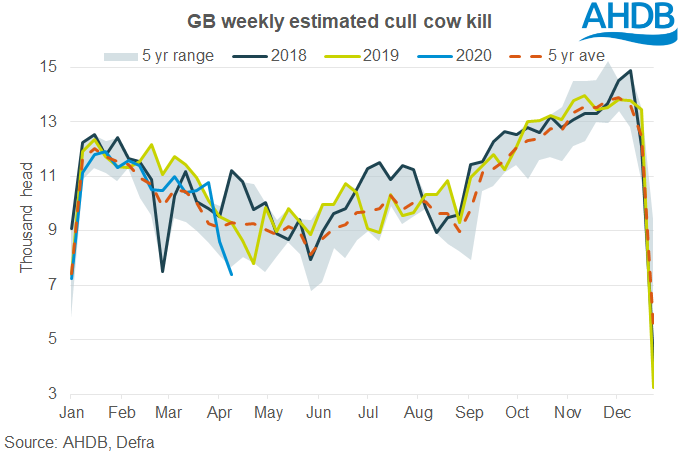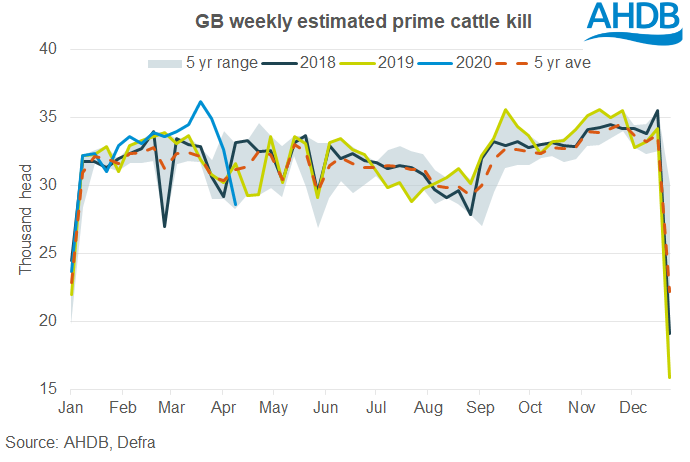Is there the capacity to increase cattle and sheep kill in GB abattoirs?
Friday, 17 April 2020
By Rebecca Wright
Since the outbreak of COVID-19 in Britain, and even more so since ‘lockdown’ there has been some concern over kill capacity in Great Britain.
On average between 200,000 and 300,000 lambs come forwards each week. Around a further 32,000 prime cattle and around 11,000 cull cows are killed, although at certain times of year these numbers are higher. Industry reports vary as to how much ‘spare’ capacity there is; some abattoirs will operate closer to 100% than others. The factors impacting on actual operating capacity include:
- Physical kill line capacity
- Availability of workers
- Cold storage capacity
- Capacity further upstream in the supply chain
Supply and demand will also impact the number of animals processed on any given week.
These are average numbers, but how many are currently being killed? Lamb kill is being recorded at some of the lowest levels in recent years. In contrast, around 3,000 more prime cattle than average were being slaughtered each week during March. Cull cattle kill was around average. We are now moving into the summer when cull cow kill typically falls. The most recent week for cattle should not be taken as being representative of what could happen next week due to it including a bank holiday.



There is some ability to switch between cattle and lambs and there have been periods where the slaughter of both species has been high at the same time. November 2019 was the most recent time for kill to be above average at the same time for both. With this being so recent, this does suggest that, subject to availability upstream and staff levels, that there is some excess kill capacity in the system at the moment.
But, just because there is excess capacity on the line does not mean the cattle or lambs will be killed. While the infrastructure of the kill line could absorb higher throughputs, there is more to consider. Reports suggest staff absenteeism at abattoirs is higher than usual, due to coronavirus. There is also supply chain logistics to consider, which are being challenged, as well as financial returns to the processors. Industry reports currently suggest profitability of killing cattle at the moment is lower or even negative in some cases. This is in part due beef mince demand being so much higher than demand for the more expensive lamb and beef cuts, but also reduced demand for other parts of the carcase including hides.
Some abattoirs are reducing the number of kill days in response to a lack of profitability, and may do so as long as the current market situation prevails.
Sign up for regular updates
You can subscribe to receive Beef and Lamb market news straight to your inbox. Simply fill in your contact details on our online form.
While AHDB seeks to ensure that the information contained on this webpage is accurate at the time of publication, no warranty is given in respect of the information and data provided. You are responsible for how you use the information. To the maximum extent permitted by law, AHDB accepts no liability for loss, damage or injury howsoever caused or suffered (including that caused by negligence) directly or indirectly in relation to the information or data provided in this publication.
All intellectual property rights in the information and data on this webpage belong to or are licensed by AHDB. You are authorised to use such information for your internal business purposes only and you must not provide this information to any other third parties, including further publication of the information, or for commercial gain in any way whatsoever without the prior written permission of AHDB for each third party disclosure, publication or commercial arrangement. For more information, please see our Terms of Use and Privacy Notice or contact the Director of Corporate Affairs at info@ahdb.org.uk © Agriculture and Horticulture Development Board. All rights reserved.
Topics:
Sectors:
Tags:

